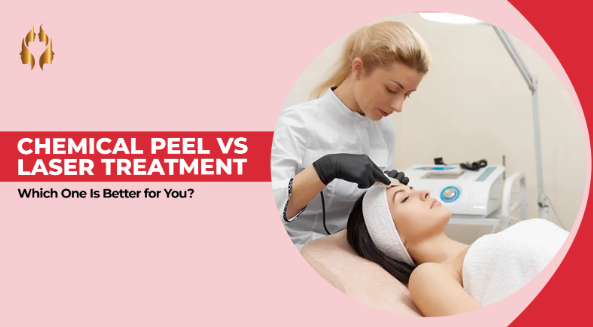Blog Details
Home > Blog> Blog Details

Successful Surgeries
Doctors
Happy Patients
If you got any questions, please do not hesitate to send us a message. We reply within 24 hours.
Chemical Peel vs Laser Treatment, Which One Is Better for You?
Two other techniques of enhancing the skin texture, tone and clarity are chemical peels and laser works although they act in different mechanisms. The most suitable one is based on your skin issues, lifestyle and tolerance towards down time. The table below will enable you to make a decision.
How They Work
Chemical peels: Acids (glycolic, salicylic or trichloroacetic acid) are used to treat the skin and are administered to remove epidermis layers of varying depths. Light peels shed the upper layer of the skin and are characterized by little pain, medium peels go to the upper dermis, deep peels go to the mid-dermis and may need IV sedation.
Laser treatments: Lasers are light energy that heats the dermis (non-ablative) or vapours the epidermis (ablative). Non-ablative lasers are less invasive because they trigger collagen growth, and ablative lasers have more impressive results in resurfacing but are associated with anaesthesia, and therefore take longer to heal.
Conditions They Treat
Chemical peels: Excellent in mild acne, bacne, fine lines, unequal texture, hyper-pigmentation, photo damage and actinic keratosis.
Laser treatments: Age spots, sun discoloration, melasma, freckles, acne scars, big pores, rosacea, skin laxity, spider veins, broken capillary and even unwanted hair.
Pain, Downtime and Results
Comfort: Light peels are associated with mild tingling; medium peels involve the use of numbing agent; deep peels are painful and require IV sedation. Those lasers that are non-ablative are like snapping rubber-bands and those that are ablative need anaesthesia, and may produce crusts and oozing.
Downtime: Downtime Light peels can result in temporary redness and scaly skin during several days. Deep peels require several weeks; medium peels require one or two weeks. The non-ablative lasers would have a short downtime, but in the case of ablative lasers, one to two weeks of wound management can be experienced.
Outputs and durability: Chemical peels make skin brighter and smoother. Light peels have low effects that take only approximately a month, medium peels last up to one year and deep peels can require years. Laser resurfacing smooths out deep wrinkles and scars and the results may last up to five years due to the type of laser used.
Side Effects and Risks
Chemical peels: It is characterized by redness, swelling, itching, scaling and sun sensitivity. Uncommon complications are infection, scarring or alteration of heart/kidney functioning in case of deep phenol peels.
Laser procedures: Could lead to redness, swelling, itching, dryness, peeling, pigmentation or acne outburst. In darker skin tones, hyper-pigmentation is more likely to occur; this can be avoided by using laser wavelength carefully and pretreating with lightening agents.
Choosing Between Them
Concern: Peels are useful in general texture, light acne and surface pigmentation. Those which are deeper, vascular or tightening lax skin are better done with lasers.
Skin tone: The people with darker complexions would need to consult an experienced dermatologist because some deep peels and lasers are more prone to hyper-pigmentation.
Downtime: In case you require the least amount of downtime, light peels or non-ablative lasers are to be considered. A deep peel or ablative laser can be worth its recovery, however, in the case of dramatic results and you can afford to be off work.
Final Thoughts
They have no universal better treatment, and each of them has advantages based on your needs. Talk to a professional practitioner about your issues, health history and habits to identify the types of chemical peel and laser therapy or a mixture thereof that will make you meet your skin targets.
Copyright reserved @ 2023 Raj Cosmetic & Plastic Surgery Centre